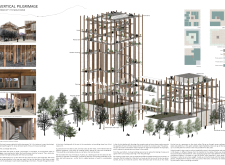5 key facts about this project
Design Integration of Nature and Community
The project represents a comprehensive response to the increasing need for sustainable urban architecture that is cognizant of its environmental context. Central to the design is the concept of vertical elevation, which mirrors the physical ascent into mountains, continuing a rich tradition of pilgrimage. The multi-functional spaces within the building facilitate various activities such as residential living, commercial operations, and cultural exhibitions. This blend of uses creates a vibrant community hub.
The architectural layout emphasizes open-air communal areas, which are pivotal to fostering social interaction among residents and visitors. Terrestrial elements such as green terraces and hanging gardens serve not only to beautify the structure but also contribute to ecological sustainability by enhancing biodiversity and improving air quality. The project notably incorporates pathways and bridges, which facilitate circulation and connect different sections of the structure, thus enhancing user experience.
Innovative Use of Materiality
Materials selected for this project emphasize sustainability and durability. Structural timber is used extensively throughout the framework, providing both an aesthetic warmth and a reduced carbon footprint. Concrete serves as a robust foundation, ensuring long-term stability, while metal accents, such as steel railings and connections, enhance the structural integrity of the design.
The extensive use of glass allows for transparency and natural light, bridging the gap between indoor comfort and outdoor landscapes. This integration of materials creates a visual and functional dialogue between the architectural elements and the surrounding environment. The project's careful selection of materials supports overall sustainability while addressing the practical needs of modern habitation.
Architectural Functionality and User Experience
The intended functionality of the project is multifaceted, designed to accommodate residential units for individuals and families, commercial space for local businesses, and versatile exhibition areas for cultural displays. This mixed-use approach optimizes space and promotes economic viability in the community.
The vertical design inherently influences user experience, encouraging exploration and engagement with both the building and the landscape. The building's height reinforces the concept of pilgrimage, offering ascending views that facilitate a connection to the mountainous backdrop. As occupants move through the different levels, they are invited to experience a range of environments—from communal gathering spaces to private retreats—underscoring the architectural intention of fostering both community interaction and personal reflection.
For a deeper understanding of the "Vertical Pilgrimage: From City to Mountains" project, readers are encouraged to explore the architectural plans, sections, and specific design elements that illustrate the innovative approaches employed in this distinctive project. Engaging with these materials will provide valuable insights into the design philosophy and the practical implications of this architectural solution.























